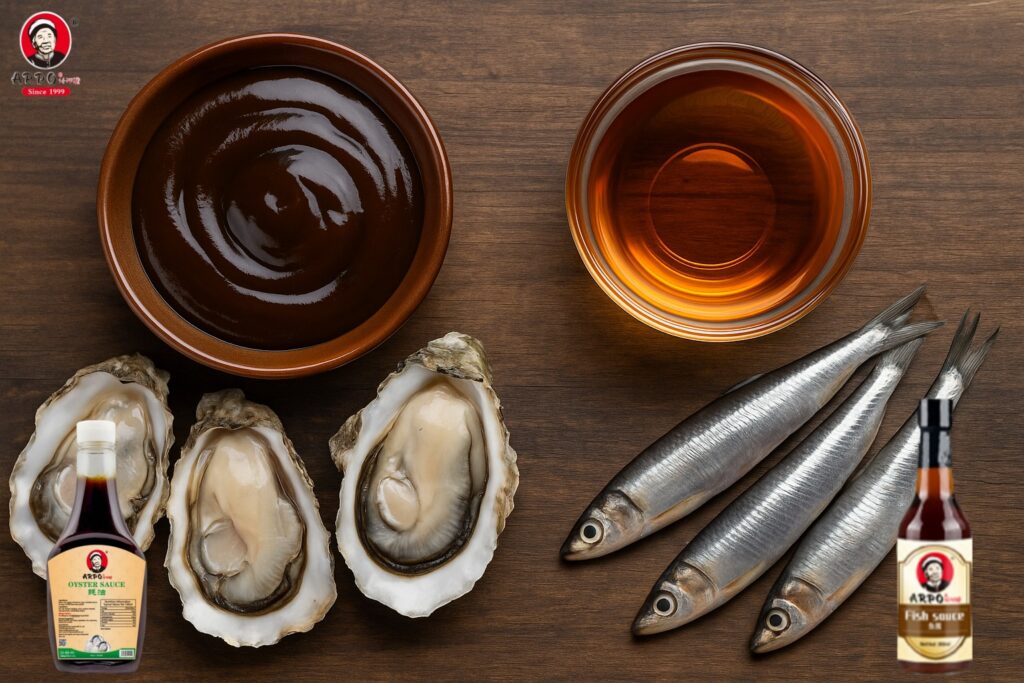OEM/ODM Ingredient Guide: Oyster Sauce vs Fish Sauce in Bulk
Introduction
In today’s competitive food manufacturing industry, ingredient selection plays a crucial role not only in taste but also in operational efficiency, compliance, and product differentiation. For businesses engaged in OEM (Original Equipment Manufacturer) or ODM (Original Design Manufacturer) production, especially in sauces and condiments, understanding the nuances between oyster sauce and fish sauce is essential. These two umami-rich sauces, while similar in their savory depth, differ significantly in origin, processing, applications, and consumer appeal.
This comprehensive guide compares oyster sauce and fish sauce in bulk manufacturing contexts—offering clarity for food exporters, brand owners, and private label developers aiming to deliver both taste and quality at scale.
Ingredient & Production Overview
Oyster Sauce
- Key Ingredients:Oyster extract, sugar, salt, starch (such as corn or tapioca), sometimes soy sauce
- Manufacturing Method:Traditionally simmered oyster extracts combined with seasonings and thickeners; industrial formulations may include caramel color or flavor enhancers such as monosodium glutamate (MSG)
- Taste & Appearance:A thick, glossy sauce with a deep, slightly sweet umami profile
- Common Variants: Vegetarian (mushroom-based), reduced sodium, gluten-free options
Fish Sauce
- Key Ingredients:Fermented anchovies or other small fish, sea salt, and water
- Manufacturing Method: Naturally aged through fermentation in wooden barrels, often for 6 to 24 months; premium types use “first press” extraction
- Taste & Appearance:Clear, amber liquid with a sharp, pungent aroma and concentrated salty umami flavor
- Common Variants:Vegan (seaweed-fermented), low sodium, unfiltered premium grades
Comparative Analysis: Oyster Sauce vs Fish Sauce
Attribute | ||
· Base Ingredients | · Oyster extract, sugar, starch | · Fermented fish, salt |
· Texture | · Thick and syrupy | · Thin and watery |
· Flavor Profile | · Rich, savory, mild sweetness | · Salty, deeply fermented umami |
· Fermentation Process | · Minimal or none | · 6–24 months natural fermentation |
· Shelf Life (Unopened) | · 24–36 months | · 18–24 months |
· Storage After Opening | · Refrigerated (up to 6 months) | · Ambient or cool storage (12+ months) |
· Typical Use Cases | · Stir-fries, glazes, marinades | · Dips, broth seasoning, salad dressings |
· Packaging Options | · Bottles, jars, drums (230g–25kg) | · Bottles, IBCs, drums (200ml–25kg) |
· Regulatory Certifications | · HALAL, BRC, HACCP, ISO, Kosher | · HALAL, BRC, FDA, ISO, Kosher |
· High-Demand Markets | · China, Southeast Asia, Europe | · Vietnam, Thailand, US gourmet segment |
Selecting the Ideal Sauce for OEM/ODM Projects
Product Functionality
Oyster sauce excels in recipes where consistency and caramelization are important, such as in quick-cooked stir-fry sauces or meat marinades. Fish sauce, by contrast, provides depth in clear broths, pickled dishes, or as a liquid seasoning that blends well with other ingredients without affecting texture.
Market Suitability
Cultural flavor preferences should guide your selection. For example, oyster sauce resonates more with East Asian and Western fusion dishes, while fish sauce remains a staple across Southeast Asian and Pacific Island cuisines.
Regulatory & Quality Standards
For large-scale exports and brand integration, working with manufacturers certified under globally recognized food safety systems (such as BRC, HACCP, ISO22000, and FDA) is critical. These certifications not only facilitate smoother cross-border trade but also enhance consumer confidence and retail compliance.
Shelf Life & Logistics Consideration
From a logistics standpoint, fish sauce’s salt-rich fermentation offers better stability in tropical climates and long-haul shipments. In contrast, oyster sauce requires refrigeration after opening to maintain consistency and freshness—important when planning cold chain logistics.
Custom Manufacturing Capabilities
A quality manufacturer like ARPO Foods provides comprehensive OEM/ODM support tailored to different regional standards and brand requirements:
- Formula Adjustments: Reduced salt, sugar-free, vegan, or no-MSG versions available
- Packaging Variety:Retail-ready glass jars and PET bottles, bulk formats like 5L jugs and 25kg food-grade drums
- Brand Personalization:Private labeling, multilingual artwork, barcodes, and compliance documentation
- Production Consistency: Automated filling lines and standardized batching procedures
- International Certifications:BRC AA-Grade, HALAL, Kosher, FDA, ISO9001 available
- Sample Provisioning & R&D:Free samples, flavor benchmarking, and recipe development
Case Highlight: Adapting Fish Sauce for the Nordic Market
One notable example involves a Scandinavian meal kit brand that sought a lower sodium fish sauce variant. In collaboration with ARPO Foods, the client received a reformulated version with 20% less salt content but identical flavor richness. The packaging was customized into recyclable 500ml PET bottles with bilingual (English/Swedish) labeling. The product complied with EU food regulations and successfully entered Nordic retail chains with consistent monthly reorders.
Frequently Asked Questions (FAQs)
Q1: Which sauce lasts longer without refrigeration?
A: Fish sauce, thanks to its natural salt fermentation, is more shelf-stable at ambient temperatures.
Q2: Can I combine both sauces in one shipment for OEM orders?
A: Yes. Mixed container loads are common practice and help optimize shipping costs.
Q3: Are there certified vegan alternatives for both sauces?
A: Absolutely. Mushroom-based oyster sauce and seaweed-fermented fish sauce are available upon request.
Q4: How can I ensure flavor consistency for private label products?
A: Manufacturers like ARPO use strict QA protocols and flavor benchmarking to ensure batch-to-batch consistency.
Q5: What is the typical MOQ for customized bulk orders?
A: Depending on the formulation, MOQ starts at around 1,000L for standard items and may increase for complex or specialty SKUs.
Final Thoughts & Contact
Whether you’re launching a new private label or scaling an existing product line, choosing between oyster sauce and fish sauce should be based on application, regional flavor demands, and your manufacturing logistics. Working with a certified and seasoned partner like Guangdong ARPO Foodstuffs Co., Ltd ensures tailored formulations, cost-effective production, and global regulatory support.
📧 Get Started with Free Samples and OEM Consultation Today
🌐 www.arpofoods.com
📩 info@arpofoods.com




